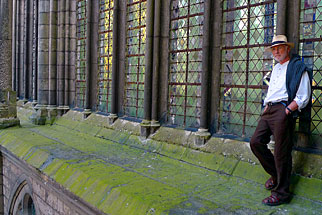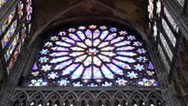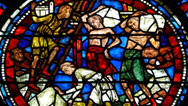Sacred Architecture
- By David Levin
- Posted 10.21.10
- NOVA
With delicate stone spires and lacy stained-glass windows, Gothic cathedrals are more like sacred sculptures than just buildings. But how did the designers of these cathedrals decide what their building should look like? In this interview, we talked to Stephen Murray, a professor of art history at Columbia University. He says that some Gothic builders were inspired by structures mentioned in the Bible.
 Listen
Listen
When designing Gothic cathedrals, some medieval builders drew on sacred measurements laid out in the pages of the Bible.
Transcript
Sacred Architecture
Posted October 21, 2010
DAVID LEVIN: You're listening to a NOVA podcast. I'm David Levin.
Gothic cathedrals are some of the crowning achievements of Western architecture. They're more like giant sculptures than just buildings—each one has delicate stone spires, and lacy stained-glass windows. Every archway, every decoration has meaning and purpose. But how did the designers of these cathedrals decide what their building should look like? To find out, we talked to Stephen Murray. He's a professor of art history at Columbia University and is an expert on Gothic architecture.
DAVID LEVIN: From a design perspective, what was guiding the architects of these cathedrals, or the designers of these cathedrals?
STEPHEN MURRAY: What was guiding, I think, the cathedral builders are partly existing buildings. So that the Bishop of Amiens, for example, might say to his builder, he might say, "Well, I'd like it to look a bit like the cathedral of Soissons in the neighboring town. But I wish we could make it a bit brighter. I wish we could make it a bit bigger. I don't particularly like the middle level." And so, in this way, objectives, I think, were hammered out in relation to existing prototypes.
But, on the other hand, you may say that Gothic is a mode of production that goes beyond anything that had ever been seen. So I think that other issues are coming to play. There are objectives in terms of prototypes in the Bible. There are objectives in terms of the application of reason to solve existing architectural problems, all kinds of things that are coming to, in a sense, modify the relationship between any given building and other buildings in the immediate past.
DAVID LEVIN: Now, in a number of these Gothic cathedrals, there are measurements that correspond directly to passages from the Bible. Can you describe how biblical numbers are used in some of these cathedrals?
STEPHEN MURRAY: Well, there, I think, when we deal with what the prototypes are, as I mentioned, a building, more than anything else, looks like another building. And so, in other words, your Gothic cathedral looks a lot like the cathedral in the neighboring town. On the other hand, the theologians are also aware of biblical architectural prototypes. So it's clear that medieval builders would want to refer to the great prototypical descriptions of artifacts and buildings in the Old Testament. The Temple of Solomon, the House of Solomon, are all described in the Book of Kings and the Book of Chronicles. Noah's ark is said to be 50 cubits wide.
But, the biblical description, I think, that had the greatest impact of all upon the builders was the description of Heaven itself, the Celestial City. And the text, the reading, I think, that would certainly come to mind was the end of the New Testament Book of Revelation, Chapter 21, where Saint John the Divine doesn't just see Heaven, but actually measures Heaven with the golden measuring rod that the angel gives him, and discovers this number of 144 cubits. Heaven is 144 cubits wide, 144 long, and 144 cubits high. So numbers like this must have resonated in the minds of the builders and the users of Gothic cathedrals.
DAVID LEVIN: And how do these numbers apply in actual cathedral construction? Where do they appear?
STEPHEN MURRAY: I think they can be found occasionally, not in all buildings, but they can sometimes be found in key units of measurement of width and height. At Amiens, the main body of the nave is very close to 50 feet. Noah's ark was 50 cubits. And then, the height of Amiens measured out in Roman feet—the local foot was a Roman foot—is 144 feet.
DAVID LEVIN: Did the numbers that they included from the Bible. did they consider those to be useful in structural terms or only aesthetic terms?
STEPHEN MURRAY: I think the numbers are not going to play a role in the structural behavior of these buildings. And it's partly an aesthetic thing that they just wanted buildings that were very tall and steep. But then, it's partly a theological aspect, to embed in the building numbers that would allow that building, in a sense, to participate in the sanctity of a prototype that one could find in the Scriptures.
For the clergy, architectural space would be understood as a means of thinking. So the idea of mentally measuring out Heaven, or mentally measuring out the Temple of Solomon, would be understood as a redemptive thing in the same way that I think the user of the church—let's say I'm a clergyman, I'm a canon at Amiens Cathedral, and I'm sitting in my stall in the divine office. I'm there for hours and hours and hours during the day, reciting the Psalms. What am I doing with my eyes and my brain? I do believe I may be scanning the building. I may be putting in my head, again, the key measurements and the shapes that the building makes. And this isn't just an intellectual, it's not just an aesthetic exercise. But I believe it's also a theological, very intelligent thing to be doing.
DAVID LEVIN: Having not been there, when you walk into one of these spaces, is there sort of a feeling that there is this order to it, that there's something more to it?
STEPHEN MURRAY: I think that's the case. In my life, I've studied, intensely, a succession of—it's been my privilege to have a procession of buildings. I tend to spend a lot of time in the building. And I watch visitors, to this day, coming in to Amiens Cathedral. And there's a sense of well being there. People stop. And the great historian of Gothic, Viollet le Duc in the 19th century, talked about even the way you breathe when you come into the building. You take a deep breath, [GASPS] and it's as if you can breathe for the first time, he writes, in this wonderful space. It just-- there's a sense of well being. You feel good.
DAVID LEVIN: Well, Stephen – thanks for so much for joining me. It's really been a pleasure.
STEPHEN MURRAY: It was a real pleasure. And thank you very much.
Credits
Audio
- Produced by
- David Levin
Image
- (Cathedral)
- Courtesy Mark Bussell/Providence Pictures, © NOVA/WGBH Educational Foundation
Related Links
-

Building the Great Cathedrals
How did medieval engineers construct magnificent skyscrapers of glass and stone?
-

Medieval Stained Glass Science
How did craftsmen of the Middle Ages make stained glass windows using little more than sand, wood, and fire?
-

Recreating Solomon's Temple
Using clues from the Bible and ancient ruins, NOVA filmmakers created detailed 3-D imagery of King Solomon's Temple.
You need the Flash Player plug-in to view this content.

